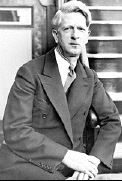April 22, 2004
Nazis and Jews: Insights From
Old Diary
By NEIL A.
LEWIS
WASHINGTON, April 21, 2004 --
James G. McDonald was an American diplomat who knew every
major public figure in the 1930's as Europe and later the
rest of the world rushed to war. He was also, it turns
out, a dedicated and precise diarist, recording his
meetings with Hitler, Mussolini and Roosevelt and
detailing his own impressions of Nazi
intentions.
|

|
.
|
|
James
G. McDonald, the League of Nations high
commissioner for refugees, aboard a ship in
1934. (AP)
|
The previously unpublicized
diaries, numbering more than 10,000 pages, are now in the
possession of the United States Holocaust Memorial Museum
and will be made public beginning Thursday. They show,
for example, that Mr. McDonald believed as early 1933
that the Nazis were considering the mass killing of
Europe's Jews. It was a view he apparently shared with
President Roosevelt, who seemed deeply concerned and said
he wanted to find a way to send a warning message to the
German people over the head of Hitler, according to the
entries.
Severin Hochberg, a historian at
the Holocaust Museum, said that the entries showed that
Roosevelt was greatly concerned and that "this picture is
very different from the claim that he was indifferent to
the fate of Jews."
The diaries of Mr. McDonald, who
served as the high commissioner for refugees for the
League of Nations, provide fresh material for what has
become a long-simmering debate among historians: Did the
Nazis who took power in 1933 have an early intention to
annihilate the Jews of Europe? Or was the plan for
genocide something that evolved over the years and was
impelled by other factors like the German Army's military
setbacks in the east?
The McDonald diaries also
provide accounts of his entreaties to Cardinal Eugenio
Pacelli, then the Vatican's secretary of state, to help
Europe's Jews. Cardinal Pacelli became Pope Pius XII, and
his behavior during the Holocaust years has produced its
own emotional debate as the Roman Catholic Church
considers his eligibility for sainthood.
Mr. McDonald, who spoke German
fluently and whose mother was German, toured Germany in
April 1933 and reported that a friend of his from Harvard
said fellow Nazis were planning the elimination of Jews
from Germany.
He met on April 3 with the
friend, Ernst (Putzi) Hanfstängl. Mr.
Hanfstängl was part of Hitler's entourage and was,
according to his own writings, enthralled with the Nazi
leader.
Mr. McDonald records that Mr.
Hanfstängl "spoke poetically" of the Nazis. He said
that when he told Hitler of an international movement to
boycott Germany, Hitler "beat his fists and exclaimed,
'Now we shall show them that we are not afraid of
international Jewry. The Jews must be crushed.' " Mr.
Hanfstängl then spoke of plans to assign a storm
trooper to each Jew.
Five days later, Mr. McDonald
met with Hitler in his office and got a softer view.
Hitler said he was not making war on Jews as such, but on
Communists and Socialists. Like many who met Hitler in
that period, Mr. McDonald noted that he had striking,
hypnotic eyes.
Weeks after meeting Hitler, Mr.
McDonald conferred with Roosevelt in the White House
about his views of what was happening in
Germany.
Richard D. Breitman, a historian
of the Holocaust at American University, said in an
interview that the McDonald diaries were not conclusive
as to when the Nazis decided on the mass killing of the
European Jews. "But they remind people that the idea of
killing Jews was there at the beginning of the Nazi
regime," he said.
The Nazi leaders generally did
not put their plans in writing, fueling the debate over
when their full intentions for the Jews became clear. The
diaries also show Cardinal Pacelli as someone who
expressed sympathy for the Jews to Mr. McDonald, but was
mainly concerned with the church's problems with the
German government.
After an Aug. 14, 1933, meeting
with Cardinal Pacelli, Mr. McDonald wrote to Felix
Warburg, a financier and friend, that he was "deeply
disappointed in the attitude" of the cardinal. He said
that during an hourlong meeting, Cardinal Pacelli was
"noncommittal but left me with the definite impression
that no vigorous cooperation could be expected from that
direction."
But in 1935, after similar
meetings, Mr. McDonald recorded that he finally got
Cardinal Pacelli's attention when he offered him a quid
pro quo; in exchange for helping Jewish refugees from the
Saar region, Mr. McDonald offered to help the Vatican
deal with a left-wing government in Mexico that was
hostile to the church.
Mr. Hochberg, the museum
historian, said it appeared that some Catholics did help
Jewish refugees after a referendum in which the Saar
voted to join Germany, but that it was unclear if
Cardinal Pacelli played any role. Nor is there any
evidence, he said, that the Vatican received help in
dealing with the Mexican government.
.